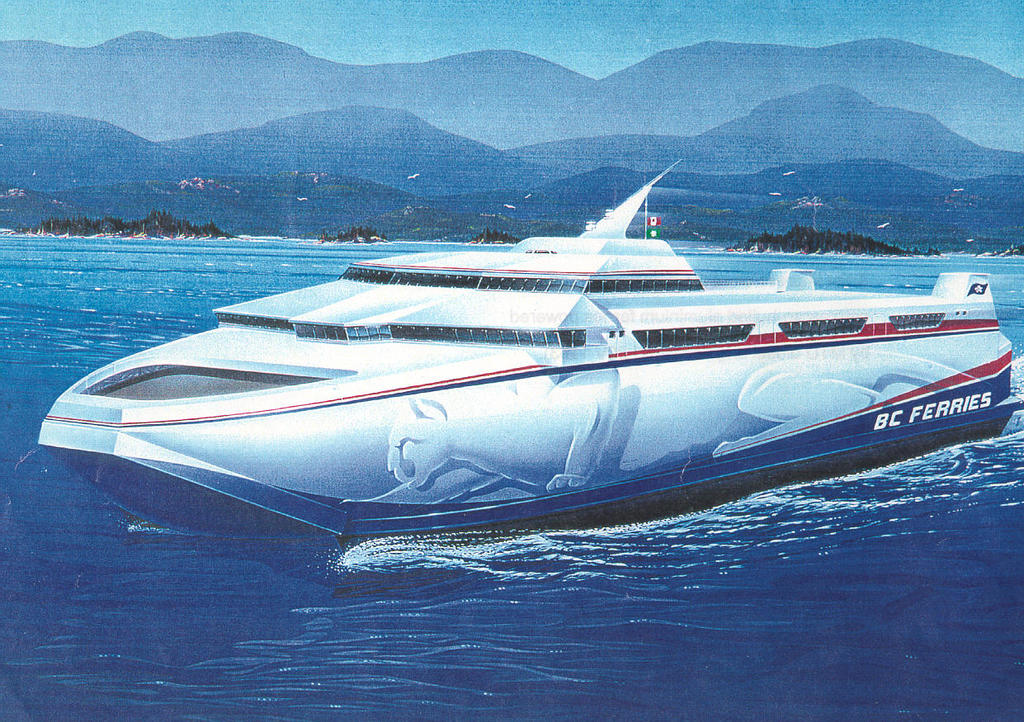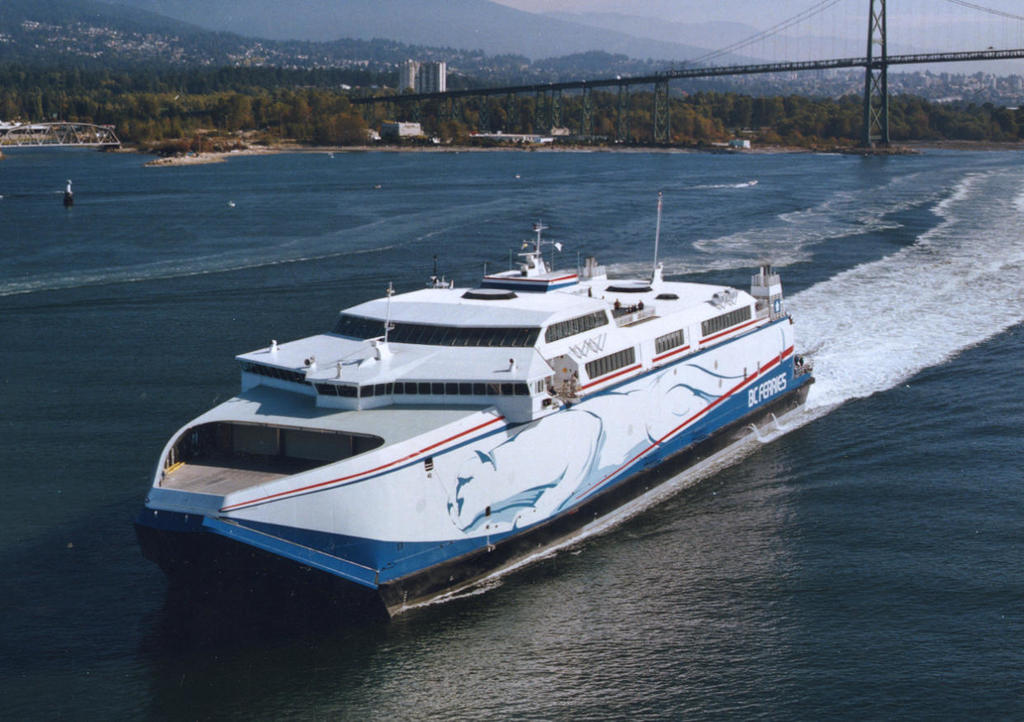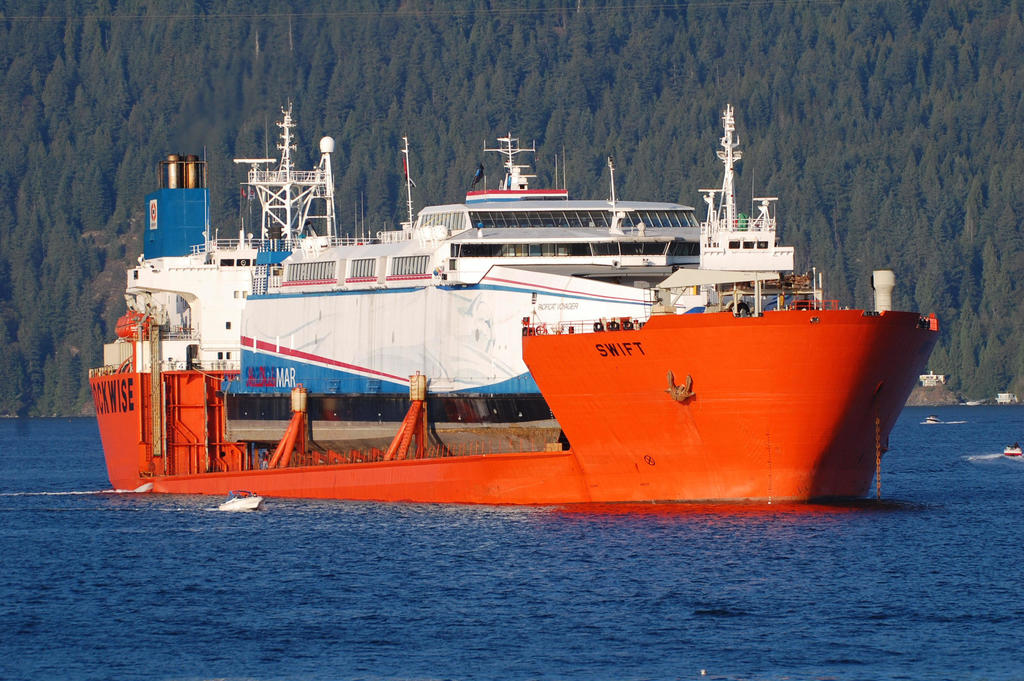Her i Abu Qir i Egypt, ligger dei to store katamaranane "PacifiCat Explorer" & "PacifiCat Voyager". Ei tredje søster, "PacifiCat Discovery" ligger vel et anna sted i Egypt uten at eg veit kor. Desse er eig av Egypt Govt Coast Guard og har lagt i opplag siden dei var nye omtrent
Dei er bygde ved Vancouver Shipyards Co Ltd / Catamaran Ferries International Inc (CFI), kor Explorer med bygg nr. 135/001 vart levert 12. Juni 1999, Discovery med bygg nr. 136/002 vart levert 6. November 1999 og Voyager med bygg nr. 137/003 vart levert i August 2000
Dessverre siden Abu Qir er ei havn kontrollert av marinen, er fotografering strengt forbudt, så ingen bilder dessverre
Men det er masse info og bilder på nettet om dei, som denne teksten som er utdrag fra en artikkel på Wikpedia:
PacifiCat-class ferry
The PacifiCat class of fast ferries was operated from 1999 to 2000 by BC Ferries in British Columbia, Canada. Three PacifiCat catamarans were built between 1996 and 2000 as part of a major public project which ultimately failed: PacifiCat Explorer (launched 1998), PacifiCat Discovery (launched 1999), and PacifiCat Voyager (launched 2000).Explorer and Discovery were briefly used for revenue service between Horseshoe Bay in West Vancouver and Departure Bay in Nanaimo. The third ship in the class, PacifiCat Voyager, was completed but never entered the BC Ferries fleet. The PacifiCat project started in June, 1994 with an estimated total cost of $210 million. By the time the ships were finished, it had actually cost $463 million. A 1999 report by the Auditor-General of British Columbia concluded that the fast ferry project had been beset by "significant breakdowns in both governance and risk management
Background
Car ferry service on the route between Horseshoe Bay, West Vancouver and Departure Bay, Nanaimo had originally been started by the private Black Ball Line in June 1953. Black Ball was purchased by the government of British Columbia on November 30, 1961 and its routes absorbed into the BC Ferries system.
Both the Horseshoe Bay and Departure Bay ferry terminals are located within residential areas. Departure Bay terminal is located at Vancouver Island's northern tip of their part of the Trans-Canada Highway, Horseshoe Bay is the mainland connection to the Trans-Canada Highway freeway. In addition, the Horseshoe Bay terminal is located in a very small cove next to a commercial marina and there have been several collisions between pleasure craft and ferries over the years.
The provincial government was aware of these issues as early as 1972, when a Ministry of Highways report recommended developing a new ferry route between Iona Island south of Vancouver and Gabriola Island south of Nanaimo.[2]:142–147 Another report recommending the same solution was produced in 1988.[2]:142–147 This proposed route is 22 kilometres shorter than the current route and would have also eliminated the problems with ferry terminal traffic. Ultimately, the government did build a new ferry terminal for Nanaimo: Duke Point, which opened in 1997 and which serves as terminus for the ferry route from Tsawwassen. Duke Point was intended to divert truck traffic away from the Horsesehoe Bay-Departure Bay route. This situation was the starting point from which the fast ferry project developed.
The project
In 1992, BC Ferries and the government began reviewing the issue of ferry service to Nanaimo. The final report, completed in January 1994, neither supported nor endorsed the use of fast ferries for service between Horseshoe Bay and Departure Bay. At a meeting in February 1994 that involved the minister responsible for BC Ferries, the corporation's management indicated that using fast ferries required "further extensive analysis." Their advice was ignored, and less than two months later the minister responsible, Glen Clark, ordered the ferry corporation to cede control over its long-term planning to the government.[3]:20 After the government finished drafting the plan, Clark pressed the BC Ferries board for a quick approval, and the Auditor-General's report about the fast ferries partly blames him for rushing the fast ferries into production.
The result was a ten-year capital plan which had been crafted by the government. It bypassed leasing a fast ferry for trials in BC waters and went directly to implementation. Several other projects previously considered essential, such as replacing one of the northern ferries, were deferred in favour of the fast ferries. In addition, the construction of the fast ferries would be used to revitalise the province's shipbuilding industry, furthering policy goals beyond merely improving ferry service to Nanaimo. The BC Ferries board, which was required to rubberstamp the plan, noted several concerns about the fast ferry aspect when asking the cabinet to give it final approval
A public announcement of the fast ferry project was made in June, 1994; it had been decided to immediately proceed with building three fast ferries. The government claimed the fast ferries would cost $210 million total, and Clark later insisted that this figure had included everything "right down to the toilet paper." The truth was that little actual analysis had been done: not even the type of ship (single hull or catamaran), nor their dimensions had even been determined when the $210 million figure was announced.
The government hoped that private shipyards would be able to build the ships on a fixed-cost basis. This turned out not to be the case; the shipbuilding industry was less enthusiastic than anticipated. Moreover, none of the shipyards being considered for the work had the facilities to build the fast ferries. BC Ferries had no choice but to do the work itself on a cost-plus basis. It would have to act as project manager and assume the risk of the fast ferries. Catamaran Ferries International (CFI), a wholly owned subsidiary of BC Ferries, was incorporated in March 1996 to carry out the work and construction started later that year.
The CFI board was suddenly replaced a year later with a new one whose members were either part of CFI management, had significant business ties to the company, or already served on BC Ferries board. According to the Auditor-General's report, this is a textbook example of poor corporate governance. It "created the awkward accountability relationship of having board members account to themselves for their performance.
Fate of the PacifiCats
On March 1, 2000, Joy MacPhail, then the minister responsible for BC Ferries, recommended to the government that it abandon the PacifiCat project, calling it "a failed experiment." Her colleagues agreed, and the ships were put up for sale at an asking price of $120 million for all three. They turned out to be difficult to sell, due to their highly specialised design and a saturated market.
After a change of government in May 2001, and more attempts to sell at a higher price, the ships were finally put up for auction in March 2003 and were sold to the Washington Marine Group for $19.4 million CAD, 4.2% of what it cost to build them. Washington Marine Group announced on July 28, 2009 that they had sold the three ships for an undisclosed amount to Abu Dhabi MAR, a luxury yacht builder.
In late 2014 the U.A.E. donated all three ferries to the Egyptian government.
Les meir på Wikipedia på PacifiCat-class ferry og Fast Ferry Scandal


Foto: James L. Shaw

Foto: Ukjent
Dei er bygde ved Vancouver Shipyards Co Ltd / Catamaran Ferries International Inc (CFI), kor Explorer med bygg nr. 135/001 vart levert 12. Juni 1999, Discovery med bygg nr. 136/002 vart levert 6. November 1999 og Voyager med bygg nr. 137/003 vart levert i August 2000
Dessverre siden Abu Qir er ei havn kontrollert av marinen, er fotografering strengt forbudt, så ingen bilder dessverre
Men det er masse info og bilder på nettet om dei, som denne teksten som er utdrag fra en artikkel på Wikpedia:
PacifiCat-class ferry
The PacifiCat class of fast ferries was operated from 1999 to 2000 by BC Ferries in British Columbia, Canada. Three PacifiCat catamarans were built between 1996 and 2000 as part of a major public project which ultimately failed: PacifiCat Explorer (launched 1998), PacifiCat Discovery (launched 1999), and PacifiCat Voyager (launched 2000).Explorer and Discovery were briefly used for revenue service between Horseshoe Bay in West Vancouver and Departure Bay in Nanaimo. The third ship in the class, PacifiCat Voyager, was completed but never entered the BC Ferries fleet. The PacifiCat project started in June, 1994 with an estimated total cost of $210 million. By the time the ships were finished, it had actually cost $463 million. A 1999 report by the Auditor-General of British Columbia concluded that the fast ferry project had been beset by "significant breakdowns in both governance and risk management
Background
Car ferry service on the route between Horseshoe Bay, West Vancouver and Departure Bay, Nanaimo had originally been started by the private Black Ball Line in June 1953. Black Ball was purchased by the government of British Columbia on November 30, 1961 and its routes absorbed into the BC Ferries system.
Both the Horseshoe Bay and Departure Bay ferry terminals are located within residential areas. Departure Bay terminal is located at Vancouver Island's northern tip of their part of the Trans-Canada Highway, Horseshoe Bay is the mainland connection to the Trans-Canada Highway freeway. In addition, the Horseshoe Bay terminal is located in a very small cove next to a commercial marina and there have been several collisions between pleasure craft and ferries over the years.
The provincial government was aware of these issues as early as 1972, when a Ministry of Highways report recommended developing a new ferry route between Iona Island south of Vancouver and Gabriola Island south of Nanaimo.[2]:142–147 Another report recommending the same solution was produced in 1988.[2]:142–147 This proposed route is 22 kilometres shorter than the current route and would have also eliminated the problems with ferry terminal traffic. Ultimately, the government did build a new ferry terminal for Nanaimo: Duke Point, which opened in 1997 and which serves as terminus for the ferry route from Tsawwassen. Duke Point was intended to divert truck traffic away from the Horsesehoe Bay-Departure Bay route. This situation was the starting point from which the fast ferry project developed.
The project
In 1992, BC Ferries and the government began reviewing the issue of ferry service to Nanaimo. The final report, completed in January 1994, neither supported nor endorsed the use of fast ferries for service between Horseshoe Bay and Departure Bay. At a meeting in February 1994 that involved the minister responsible for BC Ferries, the corporation's management indicated that using fast ferries required "further extensive analysis." Their advice was ignored, and less than two months later the minister responsible, Glen Clark, ordered the ferry corporation to cede control over its long-term planning to the government.[3]:20 After the government finished drafting the plan, Clark pressed the BC Ferries board for a quick approval, and the Auditor-General's report about the fast ferries partly blames him for rushing the fast ferries into production.
The result was a ten-year capital plan which had been crafted by the government. It bypassed leasing a fast ferry for trials in BC waters and went directly to implementation. Several other projects previously considered essential, such as replacing one of the northern ferries, were deferred in favour of the fast ferries. In addition, the construction of the fast ferries would be used to revitalise the province's shipbuilding industry, furthering policy goals beyond merely improving ferry service to Nanaimo. The BC Ferries board, which was required to rubberstamp the plan, noted several concerns about the fast ferry aspect when asking the cabinet to give it final approval
A public announcement of the fast ferry project was made in June, 1994; it had been decided to immediately proceed with building three fast ferries. The government claimed the fast ferries would cost $210 million total, and Clark later insisted that this figure had included everything "right down to the toilet paper." The truth was that little actual analysis had been done: not even the type of ship (single hull or catamaran), nor their dimensions had even been determined when the $210 million figure was announced.
The government hoped that private shipyards would be able to build the ships on a fixed-cost basis. This turned out not to be the case; the shipbuilding industry was less enthusiastic than anticipated. Moreover, none of the shipyards being considered for the work had the facilities to build the fast ferries. BC Ferries had no choice but to do the work itself on a cost-plus basis. It would have to act as project manager and assume the risk of the fast ferries. Catamaran Ferries International (CFI), a wholly owned subsidiary of BC Ferries, was incorporated in March 1996 to carry out the work and construction started later that year.
The CFI board was suddenly replaced a year later with a new one whose members were either part of CFI management, had significant business ties to the company, or already served on BC Ferries board. According to the Auditor-General's report, this is a textbook example of poor corporate governance. It "created the awkward accountability relationship of having board members account to themselves for their performance.
Fate of the PacifiCats
On March 1, 2000, Joy MacPhail, then the minister responsible for BC Ferries, recommended to the government that it abandon the PacifiCat project, calling it "a failed experiment." Her colleagues agreed, and the ships were put up for sale at an asking price of $120 million for all three. They turned out to be difficult to sell, due to their highly specialised design and a saturated market.
After a change of government in May 2001, and more attempts to sell at a higher price, the ships were finally put up for auction in March 2003 and were sold to the Washington Marine Group for $19.4 million CAD, 4.2% of what it cost to build them. Washington Marine Group announced on July 28, 2009 that they had sold the three ships for an undisclosed amount to Abu Dhabi MAR, a luxury yacht builder.
In late 2014 the U.A.E. donated all three ferries to the Egyptian government.
Les meir på Wikipedia på PacifiCat-class ferry og Fast Ferry Scandal


Foto: James L. Shaw

Foto: Ukjent
